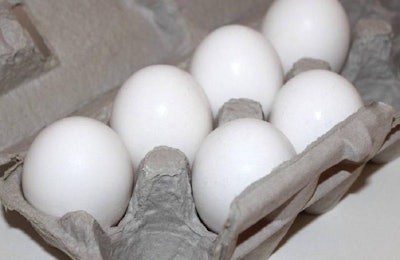
Laying hens around the world are housed in various types of systems, and in every system, shell quality is very important, explained Dr. Kayla Price, poultry technical manager with Alltech Canada, during the Egg-cellent shell quality: Learn the basics webinar, held on November 9.
Many countries around the world have a grading system for egg quality. While many of these countries focus on external quality of the egg, including Canada, the U.S. focuses more on internal quality. Regardless, a well-developed shell is important for producers when working to get a quality product to the consumer.
Proper egg development starts early
Price explained that egg development and quality starts as early as when the layers are placed in the pullet barn. While in the pullet barn, they develop the immune systems, skeleton, digestive system and physical physique they will need in order to work in production, and it’s important that this is managed correctly in order to ensure a longer lifespan for the layers. “How well she does during development really sets the stage for how well she is going to do in the laying house,” Price said.
This makes weight management crucial and something producers should work to keep uniform, Price explained.
About week 19, when layers are moved from the pullet barn, it is important to remember that this change can be rather stressful to the birds. “We’re putting these birds through stress just as we’re asking them to start producing eggs,” Price said. It will take a couple of weeks for birds to adjust and reach peak production, she added. That’s why it becomes crucial to make sure the other factors impacting egg quality are as good as they possibly can be.
Importance of calcium and other vital essentials
“With the females laying almost an egg a day, it is important she has a large calcium reserve not just for herself but for making the shell that day,” Price said. As the bird begins to get older, around 49 weeks or so, it’s then a question of how much can we give the bird so that she continues to maintain her own health while still giving producers an egg.
Controlling calcium is especially important as the birds age, Price explained. “In Canada, we are using birds up to 72 weeks, but in other parts of the world, such as the U.S., they’re using birds anywhere from 80 to 100 weeks,” said Price.
Calcium Carbonate makes up 94 percent of eggshell composition. Magnesium carbonate, glycoproteins, mucoproteins, collagen and mucopolysaccharides make up the remanding components of the shell. “While calcium carbonate is what everyone always thinks about, it is important we think about some of the proponents as well,” Price said.
Calcium absorption happens through two pathways. One way is transcellular-active movement through cell; the other way is paracellular passive diffusion through the space between cells. Gut health can impact how well calcium is absorbed.
Calcium particle size also plays a role in absorption. “Fine calcium particles are absorbed quick, whereas coarse particles take longer to actually absorb,” Price said. Different feeding programs may see value in both options. Egg formation generally takes place in the dark periods, Price explained, so calcium may be needed at the before bed feeding. “Producers need to make sure they are supplementing calcium in the feed so that the bird doesn’t have to go to the bone to produce its egg,” she said.
Other nutrients include bicarbonate, phosphorus, vitamin D, minerals, xanthophylls for coloring, and omega-3, DHA, selenium, vitamin E and B vitamins for enrichment. “A wheat-based diet without any kind of coloring, like xanthophylls, would make for a very pale egg,” Price noted. A corn-based diet makes for the naturally yellow yoke.
Minerals also offer nutritional value
Price reported that the following minerals also have a valuable use in a layer’s diet. Selenium is used for cellular protection of the reproductive tract. Copper is used for eggshell development, pigment and collagen formation. Manganese is important for the eggshell membrane and helps with the formation of bone and the organic matrix of eggshells. Zinc can be used for bone and eggshell calcification, keratin shell membrane formation and eggshell carbonate production.
Other components effecting egg shell quality
Price insinuated that while nutrition, especially calcium, is vital to eggshell quality it is not the only component. Management, age, environment and health also play a crucial role.
“The biggest neglect in all species is water quality,” said Price. Water has a huge impact on performance, she explained. “The quality of water should be tested, and producers should swab the lines,” she said.
Heat stress may also affect the layers’ ability to produce an ideal product, as with the added heat may also come an increase in respiratory rate for the female.
Of course, health is crucial. While gut health is important for absorption, it’s also important to be aware of the risk diseases can bring to layers’ performance. "Viral, bacterial and secondary bacterial diseases can be detrimental to a program, it is important to have a good vaccination program, Price explained.” Any type of illness may also add to the stress level in the house.
Age may also play a role in consistency of laying and as the birds’ ages may result in a thinner shell material that’s more vulnerable to breaking.
“Good nutrition and management practices are key to good shell quality,” Price concluded.

















